In an earlier Air-Minded post, I wrote about the early days of aerial refueling and the initial development of USAF tanker aircraft and refueling methods. This post is about the USAF jet fighters, interceptors, and attack jets that depend on those tankers to get to where they’re going and back home again.
In WWII, US Army Air Force bomber crews called escort fighters “little friends.” In the late 1940s the brand-new US Air Force contracted for a jet escort fighter, a plane that became the F-101 Voodoo. Jet engines use a lot of fuel, but aerial refueling tankers were coming into common use, so the Voodoo was designed with aerial refueling capability. If you’ll indulge me, for the remainder of this post I’ll save screen toner by referring to aerial refueling as AAR (air-to-air refueling, the acronym used in the biz).
In the early 1950s, the USAF was of two minds on AAR: it employed both probe and drogue refueling (the tanker trails a hose with a stabilizing drogue chute on the end; receiving aircraft fly up to the drogue and plug in with a probe) and boom refueling (the tanker extends a boom which connects to a slipway in the receiving aircraft). Probe and drogue was great for little friends but not so great for big friends. Fuel transfer through a rubber hose is slow, and bombers need a lot of fuel. Over time the big friends and boom refueling won out, at least with the USAF: with a high rate of fuel transfer bombers can top off quickly; fighters, whose internal fuel plumbing might be damaged by high transfer rates, take on gas at a lower rate, which can be selected by the tanker’s boom operator.
Even today, though, the USAF still uses both methods. All our bombers, strategic airlifters, command & control and surveillance aircraft, tankers themselves, fighter and attack aircraft, plus certain specialized mission aircraft and VIP transports (think Air Force One) use boom refueling. USAF helicopters & tilt-rotor aircraft use probe & drogue refueling; so do allied nation aircraft and the Navy & Marine Corps aircraft USAF tankers are often called upon to support.
Back to the Voodoo, which became operational in 1957. Both AAR methods were in wide use at the time, so the F-101 was equipped with a retractable probe and slipway. The probe was stowed in the nose when not in use; the slipway was on top, aft of the cockpit. The first photo shows an F-101A, the long-range escort fighter version of the Voodoo, plugged into a KC-97 tanker boom. The second photo shows an RF-101 reconnaissance variant with its retractable refueling probe extended, about to plug into the drogue on the end of a refueling hose (you can also see the closed slipway on top, the light gray panel halfway between the cockpit and the tail).
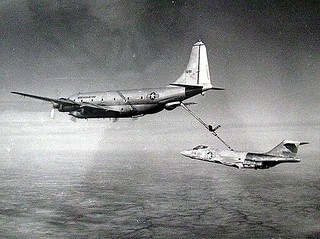 |
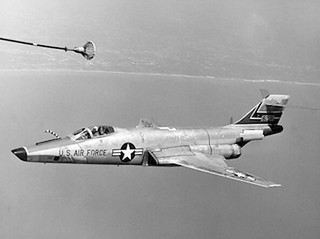 |
Another early jet fighter, the F-84 Thunderjet, although not used in the bomber escort role, also incorporated equipment for both AAR methods: a slipway in the left wing root for boom refueling, and probes on the tip tanks for drogue and hose refueling (the later swept-wing versions of the F-84, the Thunderstreak and Thunderflash, kept the slipway but did not have the tip tank probes).
 |
 |
The last of the hermaphrodite* fighters was the F-105 Thunderchief, which became operational in the late 1950s. The Thud had both a slipway and retractable probe, both mounted in the nose. Here are two photos of Thuds taking gas. In the first photo, note how the refueling hose is connected to the end of the tanker’s boom, a method still in use by USAF KC-135 tankers. In the second photo, the F-105 on the boom is a two-seat G model used for Wild Weasel surface-to-air missile suppression during the Vietnam War (with F-4 Phantom IIs waiting their turn on the tanker’s wing):
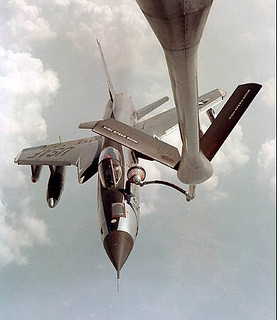 |
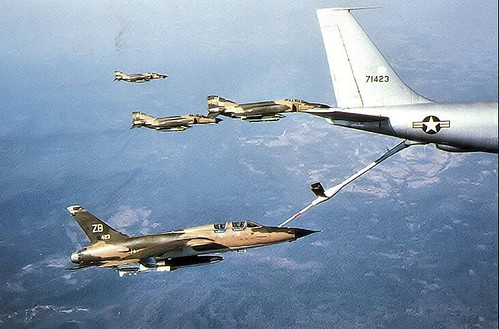 |
By the way, the Thud was one of the few USAF fighters that could conduct buddy refueling, a technique often used by carrier-based Navy and Marine fighters.
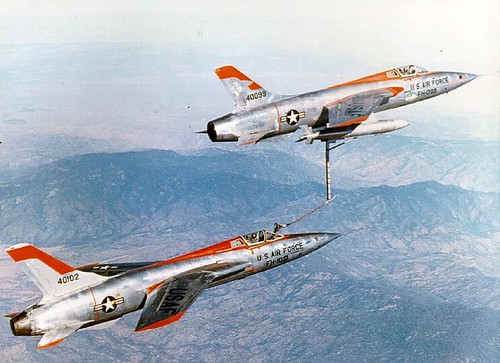
Curiously, the interceptor variant of the Voodoo, the F-101B (CF-101 in Canada), did not have AAR capability. Well, it did at first … when the F-101B became operational in 1959 it was equipped with the retractable nose probe, but a fleet-wide modification in the 1960s replaced the probe with a nose-mounted infrared seeker and AAR capability was lost. The interceptor Voodoo, perhaps because of its longer two-seat cockpit, never had the slipway. This photo of an F-101B shows the hump of the IR sensor that replaced the retractable nose probe, as well as the absence of a slipway behind the cockpit.

USAF F-80 Shooting Star and F-86 Sabre fighters (except for a very few modified for test programs) were not AAR-capable. Nor were the first USAF jet interceptors, the F-94 Starfire and F-89 Scorpion. The F-102 Delta Dagger, the single-seat delta-wing interceptor that became operational in the mid-1950s, did not conduct AAR on normal missions, but could be fitted with a removable refueling probe for long overseas flights. Photos of F-102s with the removable probe in place proved hard to find, and I thank my friend Joe Coles of the aviation blog Hush Kit for coming up with this one:
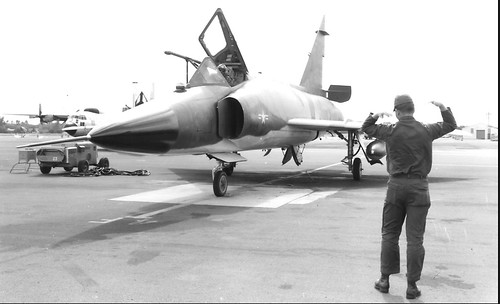
The later F-106 Delta Dart interceptor was not AAR-capable when first introduced, but was later modified with a slipway for boom refueling.
Other USAF jet fighters and attack aircraft of the 1950s and 1960s were fitted with AAR probes for hose & drogue refueling only. These included the F-100 Super Sabre, F-104 Starfighter, A-37 Dragonfly, and the F-5 family of Freedom Fighters and Tigers.
Later USAF jet fighters and attack aircraft, including all those in the current inventory, are fitted with slipways and can only refuel by boom. These include the F-4 Phantom II, F-111 Aardvark, F-15 Eagle & F-15E Strike Eagle, F-16 Fighting Falcon, F-117 Nighthawk, A-7 Corsair II, A-10 Thunderbolt II, F-22 Raptor, and F-35 Lightning II.
*I used the word “hermaphrodite” to refer to jets equipped with both probes and slipways. This is the tweet that started me thinking about the subject, posted by aviation journalist Tyler Rogoway in January. After posting, Tyler was set upon by social justice warriors who thought the term was used disparagingly, but I think it’s precisely the correct one and see no problem with it.
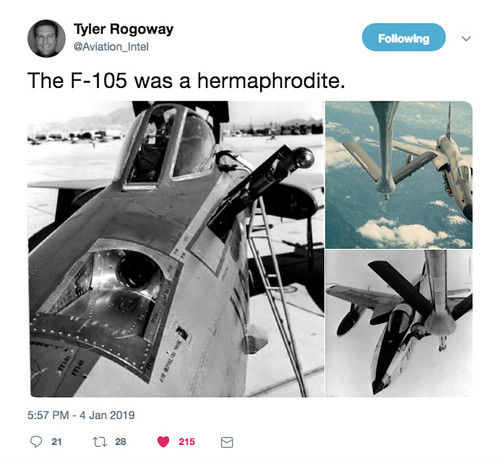
Good one, as always
Great article Paul!
Just a few notes for the tanker side of things. The B-66 was also probe-only. By the early 70’s the EB-66 was still in use in Viet Nam.
The KC-135 was an either / or boom / drogue situation. Most of the ‘135’s deploying outside CONUS carried a hose & drogue assembly strapped down in the upper deck cargo area. It took a few hours to mount / unmount the hose/drogue on the end of the boom.
With the “bag” mounted the plane bacame a “Papa” tanker. It’s callsign would something like “Tan 02 Papa”, meaning it was assigned to the Tan air refuelling anchor or area & was drogue-only.
Cheers,
Bob Clarke
Thanks for the information, Bob. If I understand correctly, the KC-46 has pods on the wings containing the hose & drogue, completely independent of the boom, so maybe scheduling refueling assets to cover different kinds of receivers won’t be as much of a hassle as it is with the 135s.